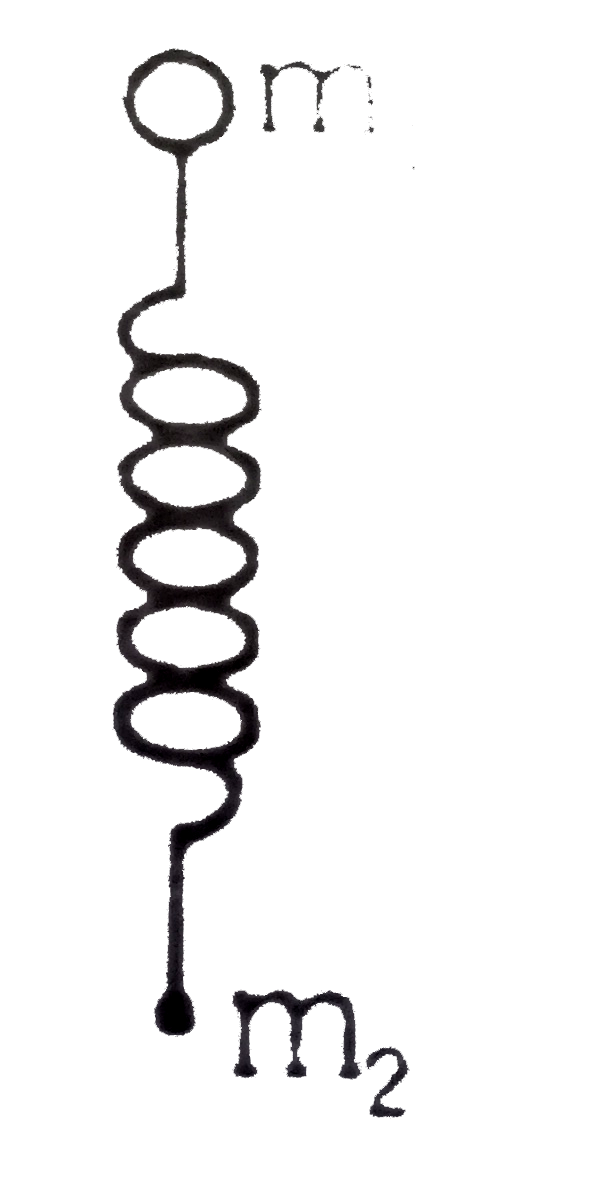Two light trollwys of masses m1 and m2(=3m1) are connected by a spring. The spring is compressed and bound by a cord. The cord is burnt through, the spring expands and the trolleys move off in opposite direction. Assume that the coefficient of friction is the same for both trollwys.

The relationship between the velocties v1 and v2 of the trolleys is v1/v2=3
The relationship between the periods t1 and t2 during which the trolleys move t1/t2=3
The relationship between the distance s1 and s2 travelled by the trolleys is s1/s2=3
The relationship between the force of friction f1 and f2 acting on the two trolleys is f1/f2=13
The correct Answer is:A, B, D
Topper's Solved these Questions
- BOOK - ALLENCHAPTER - CENTRE OF MASSEXERCISE - EXERCISE-III42videos
CENTRE OF MASS
- BOOK - ALLENCHAPTER - CENTRE OF MASSEXERCISE - EXERCISE-IV A32videos
CENTRE OF MASS
- BOOK - ALLENCHAPTER - CENTRE OF MASSEXERCISE - EXERCISE-I40videos
CENTRE OF MASS
- BOOK - ALLENCHAPTER - BASIC MATHEMATICS USED IN PHYSICS &VECTORS EXERCISE - EXERCISE-IV ASSERTION & REASON11videos
BASIC MATHEMATICS USED IN PHYSICS &VECTORS
- BOOK - ALLENCHAPTER - ELASTICITY, SURFACE TENSION AND FLUID MECHANICSEXERCISE - Exercise 5 B (Integer Type Questions)3videos
ELASTICITY, SURFACE TENSION AND FLUID MECHANICS
Similar Questions
Two trolleys of masses m and 3 m are connected by a spring. The spring is compressed and released the trolleys move off in opposite directions and come to rest after travelling distances s1, and s2, respectively. Assuming coefficient of friction is same for both the ratio of sto s1 to s2 is
View SolutionThe two masses m1 and m2 are joined by a spring as shown. The system is dropped to the ground from a height. The spring will be
 View Solution
View Solution
Knowledge Check
- Question 1 - Select One
The two masses m1 and m2 are joined by a spring as shown. The system is dropped to the ground from a height. The spring will be
 AStreched when m2>m1BCompressed when m2<m1Cneither compressed not stretched only when m1=m2Dneither compressed not stretched regardless of the values of m1 and m2.
AStreched when m2>m1BCompressed when m2<m1Cneither compressed not stretched only when m1=m2Dneither compressed not stretched regardless of the values of m1 and m2. - Question 2 - Select One
Two blocks of masses m1 and m2 are connected by a massless spring and placed on smooth surface. The spring initially stretched and released. Then :
Athe momentum of each particle remains constant separatelyBthe magnitude of momentums of each body are equal to each otherCthe mechanical energy of system remains constantDboth (C) and (B) are correct - Question 3 - Select One
Two trolleys of mass m and 3m are attached by a spring. The spring was compressed and then released , they move off in opposite direction and comes to rest after covering distances s1 and s2 respectively. Assuming the coefficient of friction to be uniform , the ratio of distances s1:s2 is
A1:9B1:3C3:1D9:1
Two blocks of masses m1 and m2 are connected by a massless spring and placed on smooth surface. The spring initially stretched and released. Then :
View SolutionTwo blocks of masses m and m' are connected by a light spring on a horizontal frictionless table . The spring is compressed and then released . Find the ratio of acceleration of masses .
View SolutionTwo blocks of masses m and m' are connected by a light spring on a horizontal frictionless table . The spring is compressed and then released . Find the ratio of acceleration of masses .
View SolutionTwo blocks of masses m1andm2 being connected with a light spring of stiffness k are driven with forces F1andF2 on a smooth plane .find the value of spring force .
 View Solution
View SolutionTwo trolleys of masses m and 3m are connected by a spring. They are compressed and released, they move off in opposite direction and come to rest after covering distances s1ands2 respectively. If the frictional force between trolley and surface is same in both the cases then the ratio of distances s1:s2 is
View Solution

